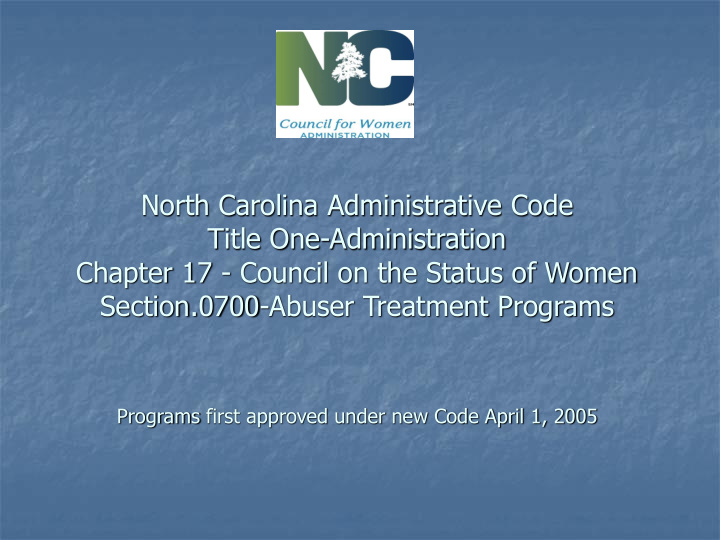



North Carolina Administrative Code Title One-Administration Chapter 17 - Council on the Status of Women Section.0700-Abuser Treatment Programs Programs first approved under new Code April 1, 2005
Domestic Violence and offenders One in three women worldwide has been beaten, coerced into sex, or abused in her lifetime. An increase in domestic violence cases has led to an increasing public demand for batterers to be held accountable for their crimes. Judges face the dilemma concerning where to refer DV offenders for intervention services.
BIP In North Carolina 1996: Chapter 50-B(a)(12), DV protective order • statute amended to include Abuser Treatment Programs (ATP). 2001: G.S. 15A-1343(b1)(9a) amended to require • that ATPs utilized by the court be approved by the Domestic Violence Commission. 2004: Final approval of ATP rules by the General Assembly
NC BIP Mission Statement adopted 2009 NC BIP’s work to bring about social change necessary to end battering and all forms of domestic abuse, to aid in the elimination of domestic violence by providing services to batterers to hold them accountable, by promoting safety and justice for all victims of domestic violence
What Offender Work is Not Not a mental health ‘treatment’ program Not an Anger Management Program Not a cure – does not work for every attendee
What is a Batterer Intervention Program? Comprehensive assessment of the offenders’ family/social/relationship/criminal history; substance abuse; and history of violent, abusive and controlling behaviors Lethality/risk assessment 26 week group, structured educational intervention challenging the underlying belief system of control and domination
Batterer Intervention Programs (BIP’s) represent one link in the chain of a comprehensive community response to domestic violence, and are most effective as a collaboration within the larger intervention system .
Out from behind closed doors Holding the offender accountable for their violence is an essential prerequisite for pursuing safety and justice for women. Emphasize and strengthen the message that the community will not tolerate abuse and will respond with multiple resources
NC BIP Summary May 2016 Statewide BIP availability: • 50 approved agencies • 72 counties have an approved BIP program • 28 counties have no BIP within their border • 14 counties have two or more BIP programs
NC District Court Access to BIP All Districts have access except District 3B, 9A, 20A
BIP Summary continued BIP’s receive no funding from the State of NC • Fee’s are locally determined • Fees range from $450 to $1040 for intake and 26 • weeks of group Weekly group fee ranges from $7 to $35. Some • offer sliding scale May offer groups for men, for women who use force, • and in Spanish
Enrolled by Referral Source 2008-2009 2014-2015 8% 3% 19% 8% 2% 5% 10% 64% 5% 76% Criminal Court Self-Referral DSS Substance Abuse Probation/Parole Mental Health Civil Court Total Referrals Accepted: 4370 Total Referrals Accepted: 3733 Total Referrals: 6146 Total Referrals: 5075
Reasons for Non-Enrollment 2008-2009 2014-2015 9% 15% 1% 5% 2% 3% 7% 2% 74% 82% New Charges No Shows Mental Health Substance Abuse Probation Revoked Referrals Not Enrolled: 1334 Referrals Not Enrolled: 1882
Participants Completing Program 2500 52% 55% 51% Number of Participants completing 57% 2000 53% 45% 38% 1500 1000 500 0 Year
Reasons for Termination 2008-2009 2011-2012 2014-2015 5%1% 8% 6% 4% 3% 8% 1% 2% 6% 1% 8% 2% 3% 78% 79% 85% Excessive Absences Non-Compliance Probation Violation Reoffended Non-Payment of Fees Substance Abuse
Challenges Belief by many, including the courts, that BIP is too expensive Civil court no-show remedy Declining number of referrals and completions (slides 11 & 13) No show after referral (slide 12) Excessive absences leading to termination (slide 14) No measurable behavioral outcome statement to demonstrate BIP impact Lack of funding for BIP staff and lack of data base
Recommend
More recommend